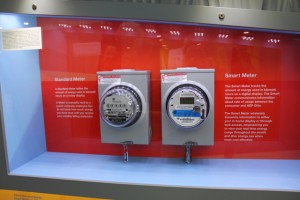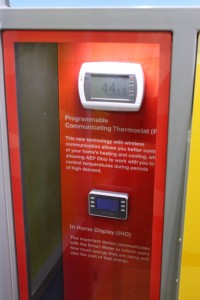Homesteaders usually tend towards old-fashioned methods of conservation. We use hand-powered tools. We line dry laundry and push a reel mower. We use renewable fuels to grill and light the fireplace. But we dare not eschew high tech solutions in combination with these old school efforts. A whole system of high tech ideas to increase efficiency is sweeping the nation under the umbrella name SmartGrid.
AEP Ohio invited me to a lunch at Alana's with other mom bloggers to learn about their new program in Ohio, gridSMART. I'm writing separately about lunch at Alana's because it was lovely enough to warrant its own post.
 The gridSMART program has many facets. The first solution to roll out are Smart Meters, digital home electric meters to replace analog ones. We learned that in north east central Ohio, households are already being given these wireless communication enabled digital meters. This pilot group will test how a digital meter allows them to view their electric usage in fifteen minute segments. AEP will use the smart meters to better regulate energy production and respond to service disruptions.
The gridSMART program has many facets. The first solution to roll out are Smart Meters, digital home electric meters to replace analog ones. We learned that in north east central Ohio, households are already being given these wireless communication enabled digital meters. This pilot group will test how a digital meter allows them to view their electric usage in fifteen minute segments. AEP will use the smart meters to better regulate energy production and respond to service disruptions.
Soon, customers with smart meters will be allowed to opt-in to a variable rate tariff that offers lower electric prices for all times of the day except peak hours of 1-7 pm. For many users, this can result in a lower electric bill while reducing usage of expensive and eco-costly peaker plants.
 Customers will also have the option to install a programmable communications thermostat hooked into their smart meter. This thermostat, provided by AEP, will communicate with the meter. During the summer, AEP may tell the thermostat to increase temperature (i.e. reduce air conditioning) by two to four degrees for short periods of time to reduce stress on the grid. Customers will have the choice to override if necessary, but full participation will give them an eight dollar credit on their electric bill.
Customers will also have the option to install a programmable communications thermostat hooked into their smart meter. This thermostat, provided by AEP, will communicate with the meter. During the summer, AEP may tell the thermostat to increase temperature (i.e. reduce air conditioning) by two to four degrees for short periods of time to reduce stress on the grid. Customers will have the choice to override if necessary, but full participation will give them an eight dollar credit on their electric bill.
I am really excited about these forward thinking programs. I am thrifty enough that I think it would be cool to monitor my energy usage on a micro-level and save money on my electric bill. I can totally see myself competing for lowest electric usage within the 'neighborhoods' AEP defines of similar homes. Some might worry about privacy with having a digital meter, but the AEP representatives assured me they have a team working on network security and very few individuals can see household use other than the customer themselves. I am far more concerned about the lack of privacy I feel when the meter reader walks through the back yard. If you have different opinions, remember that the rate and thermostat programs are totally voluntary.
To me, the worst thing about the gridSMART program is that my home is not eligible for the smart meter and communicating thermostat yet. My parents live in a neighborhood that is part of the trial and I look forward to learning how the program works for them.
Even those of us not currently eligible can read the AEP website for tips to conserve electricity and notices about other special programs, including the in-home energy audits. For a low cost, an auditor will come out to your house, make recommendations to increase efficiency and AEP offers rebates if you make the suggested improvements. The auditors will replace incandescent bulbs with Compact Fluorescents and make other minor repairs on site included in the cost of the assessment. We're signing up for one in January.
I know that these programs benefit AEP because if they can curb demand, they can avoid building expensive power plants. They are great for individual households who can lower their bills through tiered rates and communicating thermostat rebates. Perhaps most importantly, all of us benefit when energy is conserved so that we enjoy cleaner air and water.
Disclosure: I wrote this post after attending an informational luncheon on behalf of Silver Spring Networks and Mom Central Consulting and received a gift bag and gift card as a thank you for taking the time to participate. Opinions are my own.

